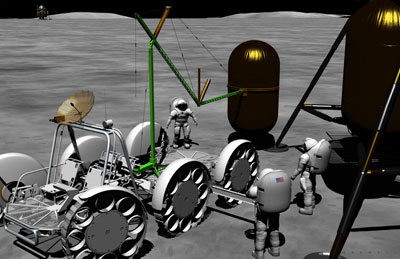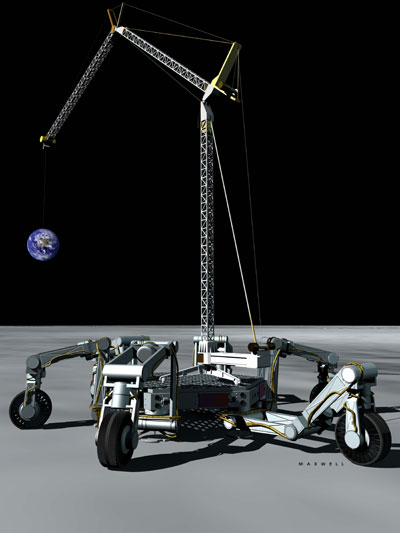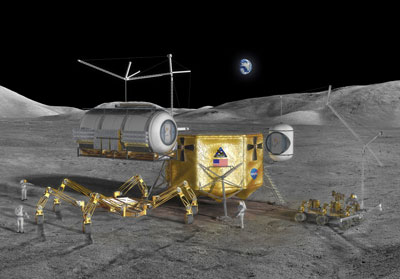Langley’s lunar manipulator: a big Swiss Army knife for planetary operationsby Taylor Dinerman
|
| The LSMS is a prime example of the kind of system NASA has said should be open to international partners. |
The problem with Altair, as with any lander design, is how to unload bulky pieces of cargo. NASA’s Langley Research Center in Virginia may have an answer, or at least the beginnings of one. The Lunar Surface Manipulator System (LSMS) is a lightweight crane that can be used to unload the lander and will likely have other uses in lunar logistics, construction, inspection, and repair. The LSMS is a fairly simple device that builds on some of the technology developed for the robotic arms used on the International Space Station (ISS).
When combined with some of the vehicles that are being designed, such as Athlete, being developed by JPL; and Chariot, at Johnson Space Center, the LSMS has the potential for becoming a versatile tool for off-Earth human exploration and development. The process of designing this device has only reached an early stage, and it will be many years before the system is ready. The challenges are operational and environmental. The team working on it has already begun work on a scoop that could turn the LSMS into a small construction machine that could be used to prepare the lunar outpost site before the habitation modules arrive. After they have been installed it could pour lunar regolith onto the module, providing a level of radiation protection.
The second and even more difficult challenge is dealing with the regolith. The US military has learned though painful experience that desert sand, in many different sizes, can wreck even the best designed machinery. In the future, dust on other worlds, such as Mars, will play havoc with the exposed moving parts of any machine if NASA and its contractors are not careful. The Mars Exploration Rovers have been extraordinarily successful in this regard and the team that operates them have many important lessons to share. However, the lunar dust is finer grained and in lower gravity behaves differently. When it comes to equipment such as the LSMS, the Moon is the place that teaches the lesson: “If you can make it here you can make it anywhere.”
 The LSMS at work unloading cargo from a lunar lander. (credit: NASA) |
Its essential role, however, is logistical: unloading supplies from the Altair lander or even from a commercial lunar surface delivery service derived from the technology that is now being devoted to the Google Lunar X Prize systems. At some point soon standardization of sizes, coupling devices, and weights of space supply containers is going to be needed. NASA cannot do this alone: it needs to negotiate agreements with the other major spacefaring nations, particularly those who have announced that they want to join in the lunar development process.
The LSMS is a prime example of the kind of system NASA has said should be open to international partners. Though it is undoubtedly an important part of the infrastructure of the lunar outpost, it is not on the “critical path”. Thus, the sooner international partners are brought into its development process the better.
What makes the LSMS particularly interesting is that it can be controlled robotically from Earth or locally by astronauts using a game-type controller. In the near future the Langley team hopes to demonstrate software that will allow for the autonomous performance of certain tasks like unloading standard-sized pods from an Altair lander. In theory a pair of Altairs with a vehicle and an LSMS could land on the Moon ahead of a human crew, unload a habitation module, and prepare it for occupation. Prepositioning supplies and a place to stay would make lunar exploration a bit easier and this in turn will help make future trips to Mars and elsewhere doable.
| If the new team at NASA and the Obama Administration does in fact decide to continue with something like the Constellation program, then projects like the LSMS will be an important piece of hardware. |
Perfecting the LSMS is not going to be easy. Based on tests carried out at Moon Lake in Washington State the LSMS looks like a good basic design, but it will take more years of hard work before the design team has a truly space-worthy system. The final product is going to have to be extremely robust. It will have to be able to keep operating for years, maybe as long as a decade. It will have to be shielded not only from dust but from powerful solar radiation storms. It will also have to be able to be repaired on site with minimal tools and by astronauts wearing space suits.
 The LSMS may hold the future of effective lunar exploration in its grasp. (credit: NASA) |
If the new team at NASA and the Obama Administration does in fact decide to continue with something like the Constellation program, then projects like the LSMS will be an important piece of hardware. In fact, it is a good example of the kind of things the Exploration Systems Mission Directorate should be building, a multipurpose device that can be adapted for future use by both manned and unmanned programs. So far it has not attracted a lot of attention, probably because its budget is fairly small. That is as it should be at this stage of development.
However, once the Moon program seriously gets going then it will be one of the systems at the heart of the effort. If the program has been well managed, it will help insure that the Moonbase can be built safely and that it is both sustainable and affordable.
